Hinduism
Brahmin Bashing – Does really deserve its due?
Published
5 years agoon
By
Vedic Tribe
~ By Udaylal Pai
Those who historically murdered, looted, raped and pillaged and destroyed are today forgiven in modern India in the name of forgetting the past. What’s more those who destroyed our cultural heritage, universities of cosmic wisdom and architectural wonders are provided with all luxuries and comforts in India. But Brahmins, who historically dedicated their lives for the sake of dharma and the welfare of the society, are still persecuted in modern India for their falsely alleged sins of the past.
Indian Brahmins, we are taught by the modern historians, have been oppressing the lower caste population in India. Brahmins are described as cunning, parasitic exploiters and creators of the iniquitous caste system. The theory of “5000 years of Brahmin oppression” is used to include every other caste in the backward classes list and religion, provide them unrestrained reservation, and justify that.
This story is repeated so loudly and so frequently that it is also treated as the truth. Much scholarship and intellectual labor was put into this thesis before it acquired its present momentum and currency. Anti-Brahmanism was a construct of the last two centuries.
They say Brahmins never allowed others to read and write. The word “Brahmin” reminds everyone of arrogant, dis-respective, communal and abusive extremists who whip the lower caste people or dalits till they die. That’s a vivid picture that paints your mind when you hear that word. The anti-Brahmin movement gained momentum when leftists, priests and religious leaders from hostile religions, separatists and casteists of different hues took this from Britishers.
Academia has always held the position that Brahmins exploited and continue to exploit everyone else, that they authored the Hindu scriptures just to ensure their own highest position in the social hierarchy, and that they are responsible for so many problems in India.
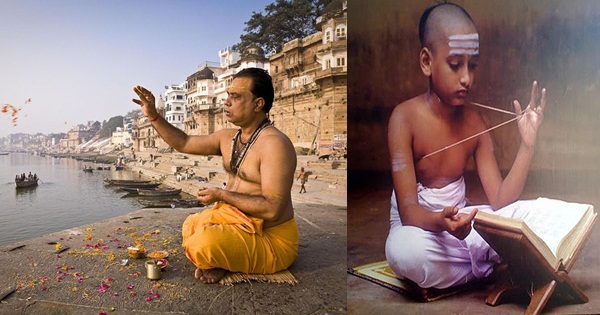
But these arguments lack historical validity and logical consistency. It is merely a case of “repeat a lie a hundred times and it will become the truth”.
Let’s think without any inhibitions and conditions. Make your intelligence and thinking unbiased and open to accept the reality. Let’s look at real facts founded upon truth. Should we lend our thinking facility to others?
If you have open mind and if you can think with clarity and logically, you would understand that 95% of Brahmins were innocents and gentle. It is amazing to see that how fiction can become truth in course of time. You don’t need big brain to make out that anti-Brahmin story was planned and planted by hostile religious invaders, colonialist and missionaries of conversion and by politicians to keep the public blind and at the same time rob Indians off everything.
The fact is that Brahmins were neither rich nor powerful at any point of time in history. They are not the Samurais of India. Every animal in the forest wants to hunt deer and eat them. The Indian Brahmins are like deer (stag) in the forest. Indian Brahmin community has become like Jews of Nazi times. Is this acceptable? The destitution of Hindu Brahmins has moved none, not even the parties known for Hindu sympathy.
For many past centuries, mostly Christians and Muslims were ruling India. Do we have to blame Brahmins for everything that went wrong in India? Brahmins have never ruled India.
Brahmins were always poor class! They never ruled India!
Can you quote any historical evidence to prove that Brahmins were kings or ruled any Indian kingdom? (Chanakya had helped Chandragupta Maurya to build a united India. After becoming the emperor of India, Chandragupta fell at the feet of Chanakya and requested him to be Rajaguru and stay in the palace with all luxuries. Chanakya’s reply: ” I am a Brahmin. My karma is to teach students and live on what they get by the way of begging. So I am going back to my village.”)
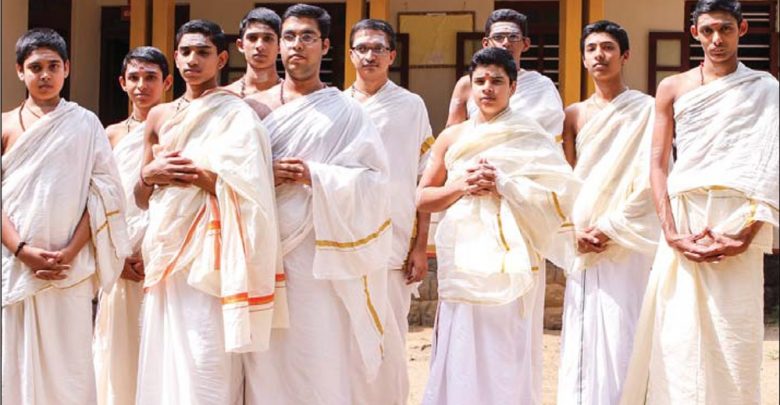
Can you find any single instance or story of rich Brahmins in history or in the mythology (purana)? Which purana mentions about a rich Brahmin? The story of Sudama (Kuchela), the poor Brahmin, is a well-known episode from Lord Krishna’s life. Incidentally, Krishna (the most popular deity of Hindus) belonged to the Yadava sub-caste. The Yadavas are currently enumerated amongst the Other Backward Castes (OBCs) in India.
If Brahmins were as arrogant as they picturised to be, how come they worship Gods from lower caste? Lord Shiva (Highest Hindu God) is often termed as a Kirata in the Puranas. The Kiratas would currently fall in the Scheduled Tribes (ST) category in modern India. Krishna (see above paragraph) was an OBC.
To be able to oppress others requires positions of power. The Brahmin’s traditional occupation was that of temple priest or purohit officiating religious functions. Their sole income was Biksha (alms) given by the land-lords (non- Brahmins). And another section of Brahmins were teachers (guru) without salary. Were those the most powerful positions?
And have you forgotten the term: ‘Garib Brahmin’ (=Poor Brahmin). Pick up any Indian story book, you will see that term quoted as a virtue. The highest stature of the society was occupied by the Brahmin ascetics and their only way of survival was alms given by people. [Of course there are exceptions, but it cannot be denied that poor Brahmins were honored. Brahmins were asked to live at a minimum and devote themselves to pursue knowledge. Ref: Alvin Toffler, an American writer and futurist, “Hinduism propagated poverty as a virtue.”]
As a matter of fact, most of the oppression of dalits (lower caste Hindus) was committed by the land-owning class (Zamindars) and not by Brahmins. OBCs also oppressed the dalits. But Brahmins became the scapegoat.
Do you know the priestly class among Brahmins is only less 20% of Brahmin population? Some of them might have been greedy or villains, as the priests or clergy in any other community/religion. (However, in the small state of Kerala, Namboodiri Brahmins were rich due to a different socio-political system.) But they never had the power that clergy of other religions enjoy.
Nobody asked non-Brahmins not to read. Brahmins by and large are in pursuit of knowledge. This made them powerful (not in material way). This stems jealousy among others. Whose fault is it anyway?
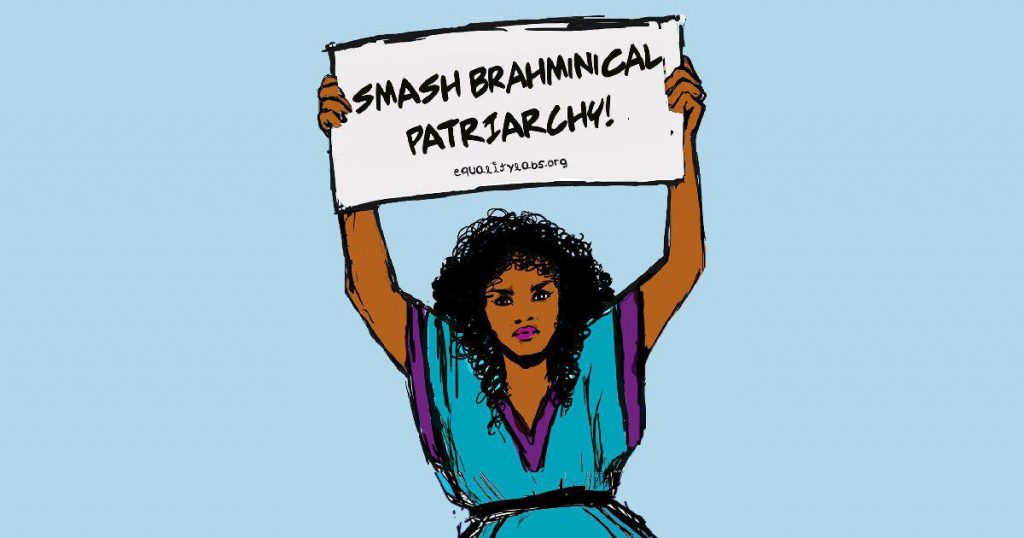
If the reading and writing was confined to Brahmins or if education were open only to the Brahmins then how do you have Valmiki composing Ramayana or Thiruvalluvar composing Thirukkural? Or the numerous works on bhakti by non-Brahmin bhakti saints etc? Brahmins never prevented others from learning. Please note that Ved Vyas who edited four vedas and wrote Mahabharata was born to a fisher-woman.
Even if you look at people Vashishtha, Valmiki, Krishna, Rama, Buddha, Mahavira, Tulsidas, Kabir, Vivekananda none of them were Brahmins. Are these not the people whose teachings we consider most valuable? If none of them were Brahmins why cry so much about Brahmin didn’t allow you to learn?
The most powerful of the dharma shaastra is the Manusmriti written by Manu. It is the only scripture that gives Brahmins a high status. But Manu was not a Brahmin – he was a Kshatriya. Gita, that describes caste system, was written by Vyasa, who was born to a backward caste fisherwoman. All ancient literature gives highest position to Brahmins, because of the virtue and ethics they upheld.
Brahmins were the seat of non-violence!
The poor hapless Brahmins were beheaded by Arabian invaders, crucified in Goa by the Portuguese Inquisition, vilified by British missionaries, and morally crucified today by their own brothers and sisters. Did anybody fight back?
Aurangzeb massacred 150,000 Brahmins and their families in Benares, Ganga ghat, Haridwar, etc…He made a mountain of skulls of the Hindu Brahmins and their children which was visible from 10 miles away. Aurangzeb has gone on record, making a pile of Brahmin “janeoos” (holy thread) and making a bonfire of them (after decapitating innocent Hindu Brahmins who refused to convert to Islam. Did any Brahmin fight back?
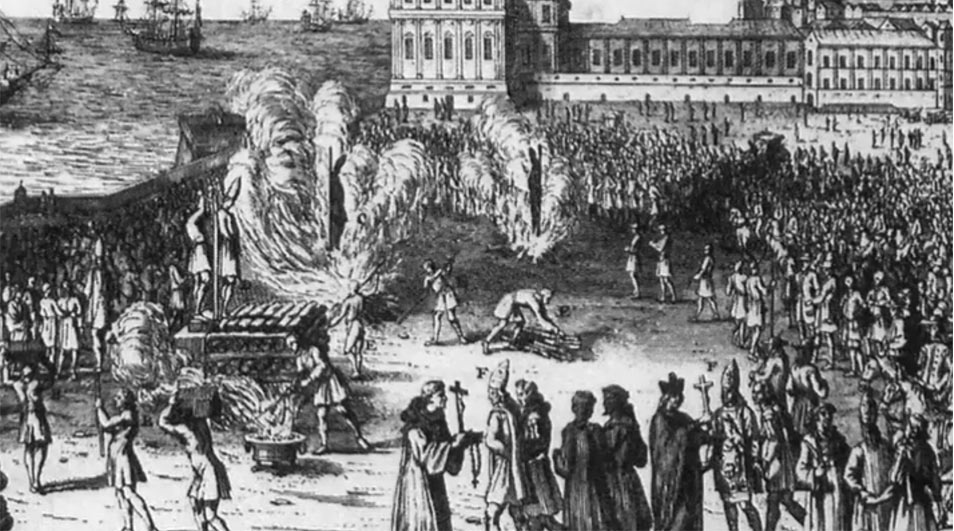
The brutal and fanatic barbarians from Portugese mercilessly persecuted and killed millions of Konkani Brahmins who refused to get converted, in Konkan-Goa. Can you show me a single example of a G.S. Brahmin killing a Portuguese?
(When the Portuguese came to India, St. Xavier wrote to the king of Portugal, his patron, “If there were no Brahmins, all pagans would be converted to our faith.” He hated them with a hatred that evangelists alone are capable of. He called them a “most perverse people.” Brahmins became a persecuted people. Thousands of Konkani Brahmins (Gaud Saraswat Brahmins) were persecuted and left Goa. They lost everything. Was there any G.S. Brahmin to fight back?)
The foreign invaders killed thousands and thousands of – Sarawat Brahmins – in Kashmir and Gandhara desa-regions-(part of today’s Afghan-Pakistan included) area. There is no sarawat Brahmin in these regions now. Can you quote a single incident of a saraswat killing an invader? Let alone killing, any violent act from sarawats?
(Pundits, the original inhabitants of Kashmir were tortured and driven out of their dwellings in Kashmir by Islamic militants trained in Pakistan. Genocide of Kashmiri Pundits has reached its climax with terrorism succeeding in ‘CLEANSING’ the valley of this ancient ethno-religious community. To escape persecution, more than 500,000 Kashmiri pundits had to leave their homes in the Valley and out of that; more than 50,000 are still languishing in uninhabitable refugee camps in Jammu and Delhi. Militants killed a lot of pundits and raped their women. Can you show me a single pundit who was involved in violence to fight back?)
Dr. Ambedkar, the father of Indian constitution, quoting Muslim historians, says the first act of religious zeal by Mohammad bin Qasim, the first Arab invader, was circumcision of Brahmins. “But, after they objected, he put all above the age of seventeen to death.” During invasions, forced conversions and Mughal periods, hundreds and thousands of Brahmins were beheaded. Can you show a single instance of a Brahmin killing a human being in any other religions?
In early 19th century, Tipu Sultan’s army descended in Melkote on a Deepavali day and massacred 800 citizens, mostly of a sect known as Mandyam Iyengars. Sanskrit scholarship had been their forte. [To this day Melkote does not celebrate Deepavali]. That slaughter rendered Melkote a near ghost town. Its environmentally connected life was broken, kalyanis – water retaining structures – went to ruin, water shortage became endemic, and the hills went brown. Sanskrit lost a home.
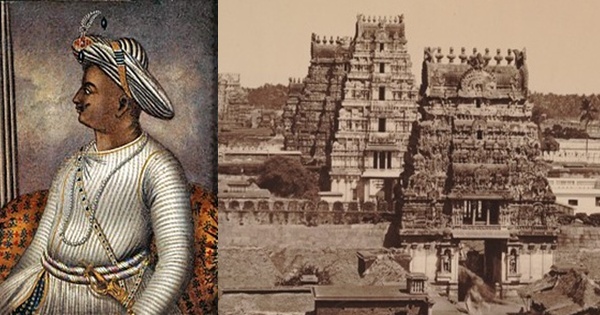
In fact the non-violent Brahmins were pure Vegetarians and ate Satvik food which does not instigate them to do any crime. Brahmins never ever defended themselves.
Please reflect upon today’s pathetic state of Brahmins!
Did you also know that most rickshaw pullers in Banaras are Brahmins? Did you know that you also stumble upon a number of Brahmins working as coolies at Delhi’s railway stations? 50 per cent of Patel Nagar’s (New Delhi) rickshaw pullers are Brahmins. 75 per cent of domestic help and cooks in Andhra Pradesh are Brahmins. There is no reason to believe that the condition of Brahmins in other parts of the country is different. The percentage of Brahmins that live below poverty line is almost 60.
Thousands of Brahmins kids immigrating to US for jobs and they make good software engineers or scientists. Why didn’t the government of India think about such brain drain that too when India lacks manpower?
The per capita income of various communities as stated by the Karnataka state finance minister in the state assembly sometime back: Christians Indian Rupees (Rs) 1,562, Vokkaligas Rs 914, Muslims Rs 794, Scheduled castes Rs 680, Scheduled Tribes Rs 577 and Brahmins Rs 537.
At Tamil Nadu’s Ranganathaswamy Temple, a priest’s monthly salary was Rs 300 (Census Department studies) and a daily allowance of one measure of rice some time ago. The government staff at the same temple receive Rs 2,500 plus per month. But these facts have not modified the priests’ reputation as ‘haves’ and ‘exploiters.’
Even if we agree hypothetically what we had learnt under the colonial-missionary-communist aegis that Brahmins were oppressors, can a civilized society accept the way politicians behave with Brahmins? If your forefather had committed a crime why should you be punished?
Some Brahmins certainly would have manipulated caste system – just the way they do in political parties or religious groups. It may be true that the past is not a clean tale for entire Brahmin community. A minority Brahmins hands may have covered in blood as it can be. And yes, it’s a closed community who doesn’t allow easily outsiders inside their homes and don’t maintain any sort of interactive relationships outside the community.
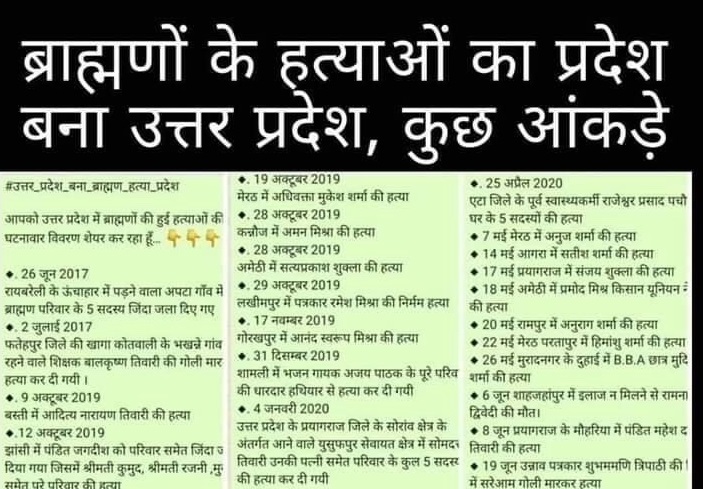
But should we generalize the whole community for the mistakes done by a small section among them? Didn’t we forgive those foreign invaders from Arabia who killed hundreds and thousands of Indians and destroyed entire ancient culture and looted the rich India? (Remember India was the richest nation before foreign invaders reached here).
How long do we stereotype people? Why the hatred? An eye for an eye will make the whole world blind.
Being a Brahmin in India seems to be a double-edged sword. If a Brahmin succeeds, then his entire caste will be perceived as privileged and not in need of assistance. But if a Brahmin commits any aberrant deed, his faults will be projected onto his entire community, leading to more public condemnation of the entire Brahmin caste. The moment Brahmins were able to do something about it, the whole society turns and gangs up on them to prevent them from getting what they deserve claiming that Brahmins suppressed them in the past – as if as minuscule and non-violent a community as the Brahmins could have kept these horrors away from wealth and power or anything leading to it.
The world has a very short memory. The world has forgotten the contribution made by Brahmins to our society. It was not just learning Vedas, Maths, Astronomy and political science, but the sacrifice they have done for entire human kind by developing Ayurveda, Pranayama, Kamasutra, Natyasastra and Yoga.
If Brahmins were selfish, they would have patented all those things. If Brahmins were selfish, they would have put at least their byline below those thousands of ancient scripts. Brahmins sacrificed their life for the well being of human being with a single motto that: “Loka Samastha Sukino Bhavantu” (May all the beings in all the worlds be happy)
In turn, the world is trying to crucify them, for no fault of them.
The intended or actual meaning of Brahmin is one who has knowledge about Brahman, the ultimate and impersonal divine reality of the universe from which all being originates and to which it returns.
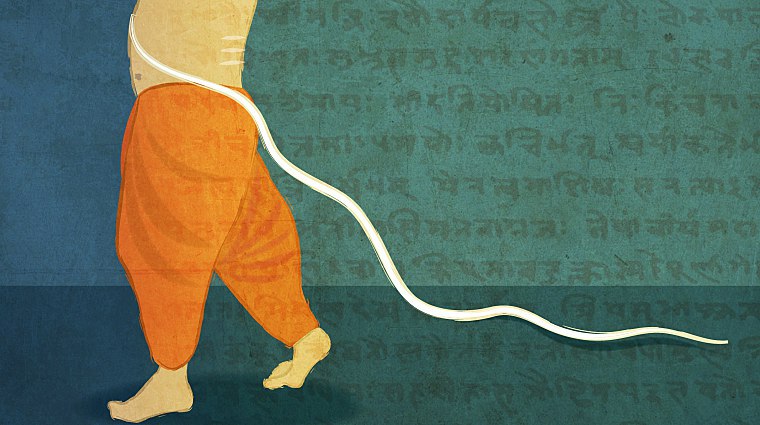
The very concept of Brahmanism is so noble and attractive that it is time that we decided to keep it above dispute. There have always been deliberate attempts to confuse the concept of Brahmanism with the caste of Brahmins in India.
Let us understand the simple fact that all members of the Brahmin caste are NOT Brahmins. Similarly, all Brahmins need not necessarily belong to the Brahmin caste.
There are four type of Brahmanism:
- Brahmana – one who is born to brahmana parents,
- Dvijaha – one who has received the samskaras starting from garbhadhana
- Vipraha – one who has received knowlege and
- Shrotriyaha – one who has all the above qualities.
Going by our classics and epics, it is very clear that the original Brahmins were definitely the ones that would command respect in any society. Brahmanism had a clear belief that the knowledge is power in the real sense. Brahmacharya which means a discipline followed with specific purpose of understanding the senses and thus taking control of the senses.
Brahmanism also wanted that the peace should be all encompassing, all creatures and all belief systems and all regions.
I am not supporting caste system, the real meaning of which is disappeared now. Our ancestors wanted to create a knowledge-based society in the name of Brahmin, that’s gone now. Alas! A huge majority of Brahmins turned to be non-vegetarians now. And I know in the name of Brahmanism some illiterate people who cannot pronounce rituals and mantras correctly performing pooja and other religious activities and making money only.
Modern Brahmins having abandoned their traditional way of life and being cut off from their traditions, suffer from an unjustified guilt complex and have swallowed this suppression propaganda uncritically. Caught between the greed of the masses, the unscrupulousness of the politicians and the malice of the real exploiters, they are persecuted mercilessly in modern India.
Are Brahmins not humans? Don’t Brahmins desire comforts, luxury and wealth for themselves and their near and dear ones, the way all people do?
You may like
-


Seven Vows and Steps (pheras) of Hindu Wedding explained
-


Atithi Devo Bhava meaning in Hinduism and India
-


Navaratri: The Nine Divine Nights of Maa Durga!
-


History of Vastu Shastra
-


Significance of Bilva Leaf – Why is it dear to Lord shiva?
-


Concept of Time and Creation (‘Brahma Srishti’) in Padma Purana
1 Comment
Leave a Reply
Cancel reply
Hinduism
Significance of Bilva Leaf – Why is it dear to Lord shiva?
Published
5 years agoon
March 12, 2021By
Vedic Tribe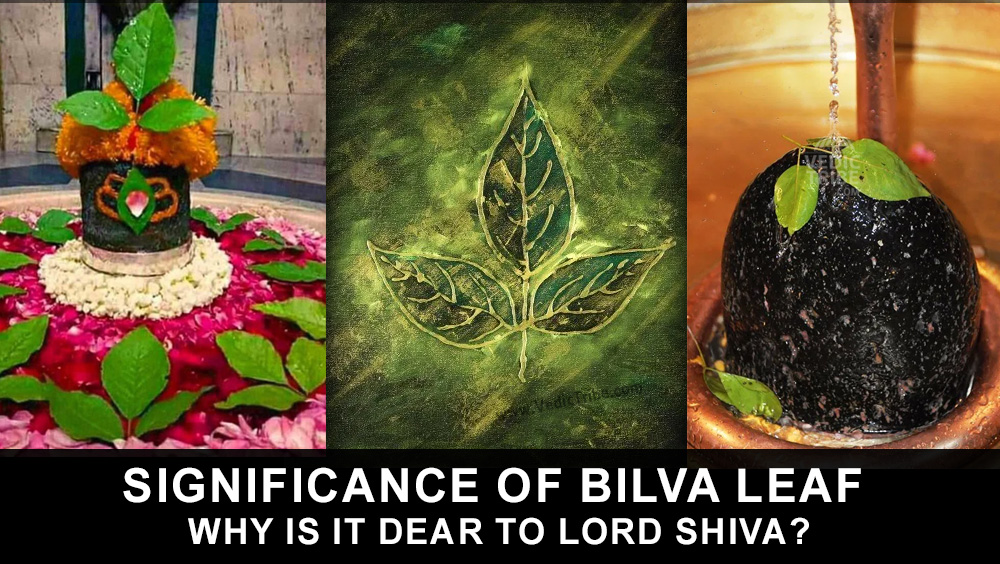
– Arun Gopinath
Hindus believe that the knowledge of medicinal plants is older than history itself, that it was gifted hundreds of thousands of years ago to the Vedic by Lord Brahma, the divine creator.
Thus when the Rishis of the Ayurveda sought to heal human suffering, they were able to draw on knowledge that had already been evolving for millennia in the forests of India. One tree about which they had a very deep knowledge was the Bilva tree. The science of Ayurveda values the Bilva highly for the medicinal properties contained in its root, fruit and leaves. According to Swami Sivananda, it is a healing tree which cures all diseases caused by vata (wind) and gives strength to the body.
More commonly known as the Bel Tree in India as well as other warm countries, this is a sacred tree having sacrificial importance and the first thing we can notice about the leaves is that they are generally trifoliate. This trifoliate leaf is symbolic of Trikaal or the Hindu Trinity of Devas known as Brahma Vishnu and Mahesh. The other names of this tree are Wood apple and its botanical name is Aegle marmilos.
The Bilva leaf or Patra as it is known, represents the Trinetra or three eyes of Lord Shiva, the main aspects like Trishakti (volition, action and knowledge), the three Shiva lingams and the three syllables of AUM or Omkar and are most favorite of Lord Shiva.
There are also five formed Bilva leaves known as PanchaDal patra found on some Bilva trees and these too are held as sacred for the worship of Lord Shiva. Bilva tree grows to a height of 8 meters with thorns. The leaves are alternate, ovate, trifoliate and aromatic. The tender leaves and shoots are consumed as salad greens. The flowers bloom in the month of May and will have a sweet fragrance.
It appears from all the Hindu texts and scriptures that the Bilva tree itself has been held very sacred and auspicious and is considered very holy since time immemorial thats its significance is mentioned in Mahapuranas in various forms of mantras. The Shiva Purana mentions a particular narration of how the usage of Bilva due to its scientific as well as medicinal properties is of great adavantage to Mankind.
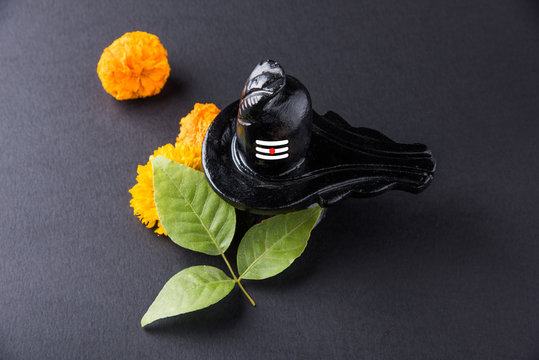
The 22nd Chapter of maha ShivaPurana narrates ” The trifoliate Bilva Patra is so sacred to Lord Shiva & is therefore a symbol of the Lord. Adored by all the Gods, its importance is difficult for anyone to comprehend. The sacred tree can only be known to a limited extent. Sacred sites of this Earth can only find their place at the root of this auspicious tree. Those who meditate upon Lord Mahadeva in His form of linga at the root of Bilva obtain Moksha & become purified souls by attaining Shiva. Such are the marvels of this sacred Bilva.”
The famous Shri Bilvashtakam (v. 6–7) Mentions :
Lakshmyaascha stana utpannam Mahaadeva sadaa priyam,
Bilva vriksham prayachchhaami eka bilvam Shivaarpanam.
Darshanam bilva vrikshasya sparshanam paapanaashanam,
Aghorapaapasamhaaram eka bilvam shivarpanam.
Translation :
Born from the heart of Goddess Lakshmi, the Bilva tree is ever dear to Mahadeva. So I ask this tree to offer one Bilva leaf to Lord Shiva. Even if (one) has darshan ( view) of the Bilva tree, and touches it, surely frees one from sin. The most terrible karma is destroyed when a Bilva leaf is offered to Lord Shiva.
It is also believed that Lakshmi, the Goddess of Wealth, also lives in the bel tree. Those who perform the puja of Shiva and Parvati devoutly, using the leaves, will be endowed with spiritual powers.
Scientific Advantages
According to Hindu scriptures, the Bilva is Triguna which is connected to the three Gunas or components of natural characteristics of the tree. In Hindu philosophy, the three Gunas are Sattva, Rajas & Tamas with Sattva being the pure most while Tamas normally is to do with darkness & ignorance.
The Sattvic component is believed to be more centered within the bilva patra and therefore the high capacity to absorb and emit Sattvic frequencies. This has various effects on the environment as well as on anyone merelt touching the leaf. One of them is the reduction of Rajasic-Tamasic atoms present in the atmosphere & more importantly within the human body.
A Sattvic leaf like bilva patra when brought in proximity of a person suffering from negative energies such as distress and anxiety is believed to medically reduce these energies within the human body. People with negative outlook towards life and their environment normally do not realize they have negative energies building up within their body and are at a risk of subconsciously harpering destructive thoughts also.
Whenever such people come into contact with a Sattvic atmosphere, what they fail to realize is their negative energies try to fight the positivity of a Sattva predominant environment. This struggle can build up at various levels and can vary from the human mind thinking negatively and can result sudden bursts of anger to destruction of things around them.
Medicinal uses
The roots, skin, fruits and the leaves of the Bilva tree are used for medicinal purpose. Bilva has astringent, edema lessening, anti-diarrhea, laxative and appetizer properties hence, can be used to cure both internal and external diseases.
The sacred tree has many medicinal usages and is advantageous in curing many human ailments such as :
- Bleeding gums.
- Bel fruit clears diarrhea, dysentry, phlegm, high blood pressure, morning sickness in pregnancy, stress.
- Asthma can be controlled when a mixture of dry bel leaf powder & honey is consumed daily
- Jaundice can be cured by consuming the extracted juice of the bilva leaves
- Anemia can be cured by drinking the powder of the bel fruit mixed with milk
- Bel fruit keeps the skin rejuvenated when pasted into a face pack; also cures joint aches
Hinduism
Concept of Time and Creation (‘Brahma Srishti’) in Padma Purana
Published
5 years agoon
March 12, 2021By
Vedic Tribe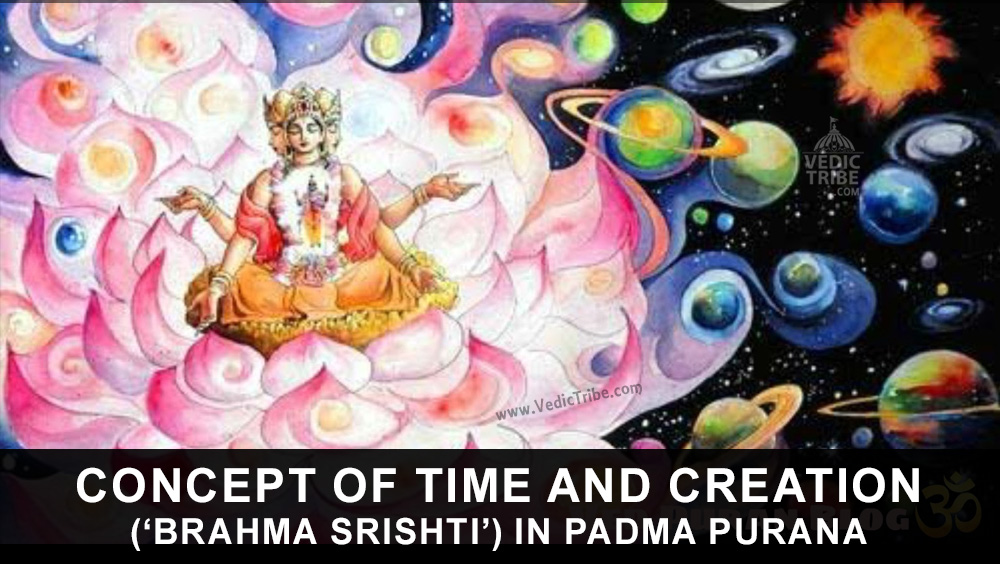
Pulastya Maha Muni affirmed to Bhishma that Brahma was Narayana Himself and that in reality he was Eternal. But in a formal sense it was stated that Brahma was ‘created’ and in that normally recognised manner Brahma had hundred years of age; apparently, the concept of Time would have to have a basis and that was why Brahma’s age was determined notionally as of hundred Brahma Years; in other words, ‘Para’or the first half was over and his present age has entered the ‘Paraartha’, the second half (viz. Fifty first year).This was how, the concept of Time emerged.
Every fifteen ‘Nimeshas’ constitute one ‘Kaashtha’; thirty Kashthas one one ‘Kala’; thirty Kalas make one ‘Muhurtha’; thirty Muhurtas make one day/night, thirty day/nights make on ‘Maasa’; (half Maasa makes one ‘Paksha’), six Maasas make one ‘Ayana’ and two Ayanas-Dakshinayana and Uttarayana- make one ‘Year’. Dakshinayana is a night for Devas and Uttarayana their day. One hundred human years make one day-night of Devas.
Twelve thousand Deva Years make four Yugas viz, Satya Yuga, Treta Yuja, Dwapara Yuga and Kali Yuga and these four Yugas make one Maha Yuga which is Brahma’s one day! Satya Yuga comprises 4800 DevaYears including ‘Sandhya mana’ of 400 years and ‘Sandhyamsha maana of additional 400 years; Treta Yuga comprises 3600 Deva Years including 600 years of ‘Sandhya/ Sandhyamsha mana’each; Dwapara Yuga of 2400 years including 200 years of ‘Sandhya/ Sandhyamsha mana’each and Kali Yuga of 1000 years including 100 years each of Sandhya / Sandhyamsha manas.Deva Years are 360 times more than human years. For instance, the duration of Kali Yuga in human year terms is 432,000 years; Dwapara’s is 864000; Treta Yuga’s is12, 96,000 and of Satya Yuga is 17, 28,000 years; all the Yugas totalling 432, 00, 00,000 (432 million) make one Chaturyuga and that constitutes one Brahma Day!
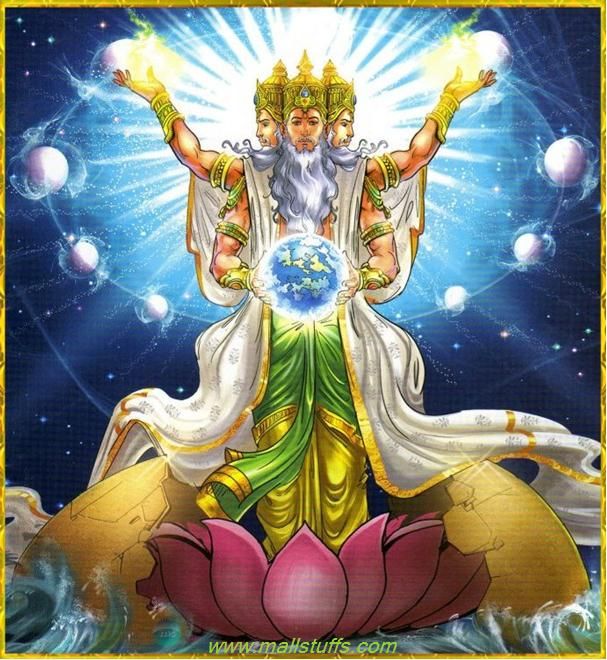
In one day of Brahma there are fourteen Manvantaras and each Manvantara has 8, 51,000 of Deva Years. There are two kalpas on one day-night of Brahma.At the end of the previous Kalpa, Brahma felt fresh from the previous night and found that Prithvi was submerged in water while Bhagavan Varaha Deva entered into water and Prithvi prayed to him; in response, Varahadeva emanated a ‘Ghur Ghur’ sound which was like the reverberation of Sama Veda, lifted up Prithvi from Rasala loka by the might of his horns, Devas rained fragrant flowers from the sky, Rishis went into rapturous tributes to Vishnu’s incarnated Varaha Rupa; and Brahma implored the latter to allow him recommence Srishti with his blessings as also to preserve and administer the Creation that he would so generate even as the Lord gracefully replied to say: ‘Tathastu!’ (So be it!).
Brahma’s first Srishti being Maha Tatva, the creation of Tanmatras was known as Bhuta Sarga or the Second Srishti; Vaikarika or Satvika Ahankara was the third Srishti of Indriyas or Aindriya Sarga; the Fourth Srishti is the Mukyha Sarga related to Mountains, Forests and other Sthaavara Srishti; the fifth Srishti relates to Pashu-Pakshi (Animals and Birds); the seventh Srishti was called Deva sarga or Urthva faced and was of Devas; and Seventh Srishti was of Manava Sarga; the Eighth was of Anugraha Sarga which could be of Satvika or Tamasic nature and finally the Ninth Srishti called the Kaumara Sarga which could be of Prakrita or Vaikrita Marg.
Depending on the carry forward of one’s own balance of ‘Papa-Punya’of the previous time-frame preceding the Pralaya, placement of lives was commenced by Brahma in the New Age. Arising out of his ‘Manasika Samkalpa’ (Mind born Proposal), Brahma created various species including Devas, Asuras, Pitaras and human beings. From his thighs, the evil Asuras emerged and as per his free will various birds were created.
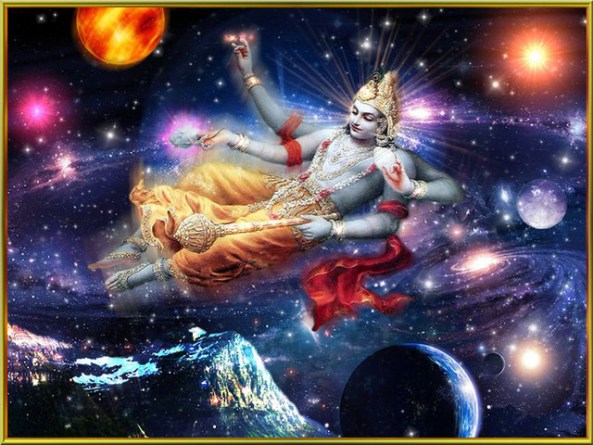
From his stomach surfaced cows, his shoulders the wolves; his face created horses, elephants, asses, nilgais, deer, camels, etc.each species multiplying several others. Brahma’s body hairs created fruits, roots and foodgrains. From his right extreme face, Brahma created, Gayatri Chhandah, Rig Veda, Tivritstoma, Rathantara, Agnihoshtha yagna; from South-faced he created Yajur Veda, Tristhub Chandas, Panchadasha stoma, Brihatsaama, etc; Sama Veda, Jagati Chhanda, Saptadashastoma, ‘Vairupa’ etc; from the Western face; Brahma created Ekavimshatstoma, Atharva Veda, Aptoryama, Anushthup chhanda, and Vairaja from the Uttaravarti Mukha. Miscellaneous ‘Pranis’ were created from any of the limbs of Brahma. To sum up thus at the beginning of the Kalpa, Prajapati Brahma created Devas, Asuras, Pitaras and human beings as also of Yakshas, Pishachas, Gandharvas, Apsaras, Siddhas, Kinnaras, Raakshasaas, Lions, Birds, Animals and Reptiles.
Focussing attention on human beings now, Bhishma asked the highlights of Varnashrama Vidhi and Pulastya Muni explained that Brahma created Brahmanas from the face, Kshatriyas from ‘Vakshasthali’ (chest), Vaishyas from thighs; and Shudras from the feet.These four Varnas are the important constituents of ‘Yagnas’; Devas are satisfied wirh their respective portions of ‘Havis’ (oblations) to Agni and being pleased with the Yagnas, Devas bestow good rains and good crops which leads to material prosperity.
The hearts and hands of every body tend to be clean and social customs and virtuous living would go hand in hand. Prajapati decided the duties of the Four Varnas, depending on the professions that human beings tended to follow like Brahmanas performing Yagnas, Vratas, Temple Tasks, and enabling various religious deeds of Virtue in favour of the members of three other Varnas etc.; Kshatriyas discharging the responsibilities of Kingship, Administration, Security against external enemies, collection of taxes and maintenance of Internal Law and Order; Vaishyas performing business, farming, trading and all matters involving finance, provision of materials to others by allowing reasonable profits for the services given etc. and Shudras supporting the members of the Three Varnas in the discharge of duties being undertaken by them.
Brahma materialised the above various kinds of Creations by applying his mental faculties but was not quite satisfied as the next generations so created were not adequate to fill in the universe; therefore he created Sages like Bhrigu, Pulaha, Kratu, Angira, Marichi, Daksha, Atri and Vasishtha, in addition to the four ‘Manasa Putras’ viz. Sanaka, Sanandana, Sanatana and Sanat Kumaras. As not all these sons were interested in family lives, Brahma created Rudra from his forehead and decided that half of the body be a woman; thus Eleven Rudras got materialised along with as many Rudranis who had a variety of Rupas ranging from ‘Sowmya’ (composure), ‘Krura’(unkindness), ‘Shanta’ (peacefulness), ‘Shyama’ (darkness), ‘Gaura’ (wheatish) and such other colours.
Further on, Brahma created Swayambhu Manu and the latter’s wife Shatarupa; the Manu couple gave birth to sons Priyavrata and Uttanapada and daughters Prasuti (married to Daksha) and Akruti (married to Ruchi Prajapati). To Prasuti and Daksha were born twenty four daughters, thirteen of whom were Shraddha, Lakshmi, Dhruti, Pushti, Tushti, Megha, Kriya, Buddhi, Lajja, Vapu, Shanti, Sidhi, and Kirthi (all these thirteen were married to Dharma); eleven more daughters were Khyati, Sati, Sambhuti, Smriti, Preeti, Kshama, Sannati, Anasuya, Urja, Swaha and Swadha; they were wedded respectively to Bhrigu, Shiva, Marichi, Angira, Pusasthya, Kratu, Atri, Vasishtha, Agni and Pitras.
The sons of Daksha’s daughters were Kamak by Shraddha, Darpa to Lakshmi, Niyam to Dhriti, Santhosh to Tushti, Lobha to Pushti, Shruta to Megha; Danda, Vinay and Naya to Kriya, Bodha to Buddhi, Vinay to Lajja, Vyavasayak to Vapu, Kshema to Shanti, Sukha to Siddhi, and Yash to Kirti.These were all the sons of Dharma. Kaam and Nandi gave birth to Harsha, the grand son of Dharma. Bhrigu and Khyati gave birth to Devi Lakshmi who was Lord Narayana’s wife. Bhagavan Rudra accepted Sati as his wife (Daksha’s daughter) but Devi Sati sacrificed her life pursuant to Daksha’s Yagna to which Rudra was uninvited but Sati insisted in attending it; she felt highly insulted by her father Daksha who also offended Rudra Deva and Rudra eventually destroyed Daksha Yagna. — with Srilan Srisukumaran.
Hinduism
Karma Yoga – Yog Through Selfless Actions
Published
5 years agoon
February 23, 2021By
Vedic Tribe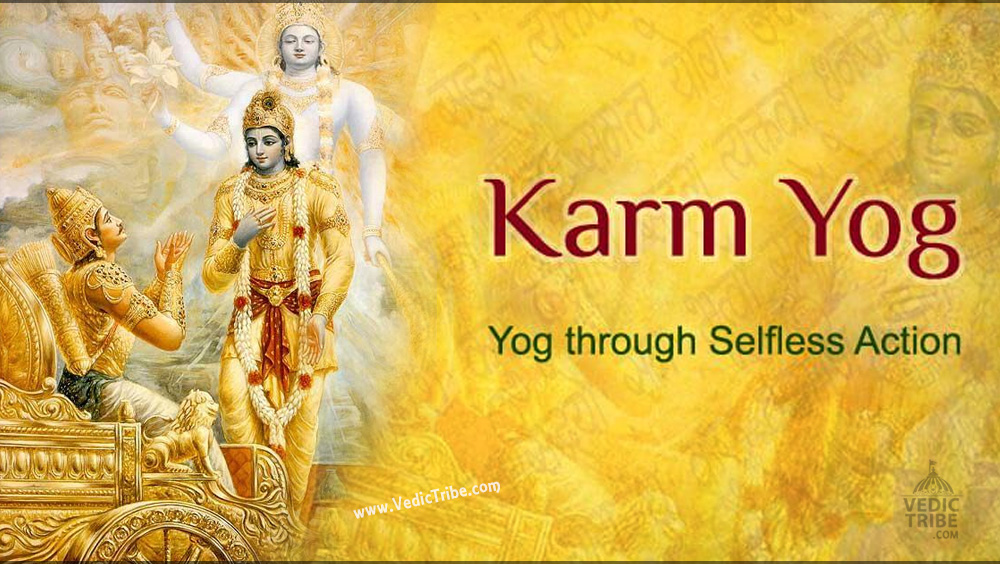
Karma Yoga is Meditation in Action:
“Karma” means action and “yoga” means loving unity of our mind with God. To perform karma and also practice yoga means to remain engaged in activity in the world while remaining in a state of devotional unity with God. This is true spiritual action.
Your bhakti yoga meditation practice will combine all these aspects and it will include:
- Daily sitting meditation
- Daily dynamic meditation woven seamlessly into the fabric of your life’s activities
Before we look at guidelines for these, let’s explore how process is described in the Hindu scriptures.
Karma Yoga of the Bhagavad Gita:
One of the most important scriptures of Hinduism, the Bhagavad Gita, was revealed under unusual circumstances: moments before a war and in the middle of a battlefield. It is comprised of a 700-verse dialogue between Lord Krishna, supreme God, and Arjuna, his loving disciple.
The all-in-one solution of the Bhagavad Gita for eliminating karma is Lord Krishna’s advice to practice akarma or actions that have no karmic consequence.
If we could perfect akarma in daily activity, the consequences of our actions would automatically be neutralized — even though we are engaged in action.
This means that from the point of view of karmic debt, no consequences would be added to our “account”. The only key to this is we must maintain an unbroken and continuous devotion to God.

Karma yoga philosophy in the Bhagavad Gita is summed up in one statement of Lord Krishna:
“Remember Me and fight.”
But is it really possible to simultaneously do devotional remembrance and be engaged in activity? Can the mind function in two places at the same time? This is definitely impossible, but for karma yoga to be done properly, both have to happen simultaneously.
For example, if you are at work and absorbed in a project, and remember God occasionally, how are both these actions accounted for as karmas?
The time you spent in devotional remembrance will be considered devotional action, and the time you spent engrossed in working will be considered normal action. This is not karma yoga.
Plus, a common misconception describes karma yoga as “performing action without being attached to the results”. Although this sounds noble, is it psychologically possible for any human being to do this?
The fact is because we are constantly trying to find authentic happiness, we will always anticipate the outcome of our actions in advance of doing them.
The practical form of the Gita’s karma yoga…
In the Gita, Krishna was both supreme God and Arjuna’s spiritual guide. Krishna advised Arjuna to surrender to Him and to simply follow His instructions. By transferring his motivation for action to a divine personality, Arjuna would not be responsible for the outcome of the actions he was instructed to perform.
For example, a police officer is issued a revolver, which he is instructed to use in the line of duty by his superiors. It could happen that he kills someone in the pursuit of law and order. In the eyes of the justice system, this will not be considered a crime. He did not use his own mental motivation to decide to kill someone — he simply followed the guidelines given to him by his superiors.
In Arjuna’s situation, in spite of engaging in war, all his actions were counted as devotion, because his heart, mind and body were fully dedicated to the will of Krishna.
This again highlights one of the most important points of karma yoga: The mind is the performer of action, not the physical body.
It is our personal motive that has to be carefully redirected for karmic consequences to change or be neutralized.

A Closer Look at the Spiritual Theory
If a practitioner is surrendered to a true divine Guru, and performs actions entrusted to him by his Guru, that activity is considered not only karma yoga, but also bhakti or spiritual action. It will be free of a karmic consequence. That practitioner is not directly attached to the results of that activity because his motive is to follow the instructions of his Guru.
Arjuna accepted Lord Krishn as his Guru at the very beginning of the Gita when he declared he was Lord Krishna’s disciple. He preserved the understanding during the entire Mahabharata War that he was doing service for his Guru.
In this way, just by holding this intention, his devotion remained unbroken and his actions were considered karma yoga. Thus, service to a true Guru is called karma yoga or devotion.
Practically speaking, a Guru will give instructions on how a practitioner can keep his mind engrossed in a state of continuous devotional remembrance. Simply by following these instructions, a disciple is automatically practicing karma yoga.
Those devotional guidelines take the form of (1) karma sanyas and (2) karma yoga.
Karma Sanyas – Quiet Time for Meditation
And old method of dyeing fabric in India was to place a cloth in a dye bath and then allow it to dry in the sun.
After drying, the intensity of the color faded. Again the cloth was placed in a dye bath, again it was placed in the sun, and again the color faded, but the second time more of the color remained.
After entering the dye bath multiple times, the color eventually became intense and fixed.
Similarly, to establish devotion in our hearts and minds, it is important to have a structured daily practice of sitting meditation.
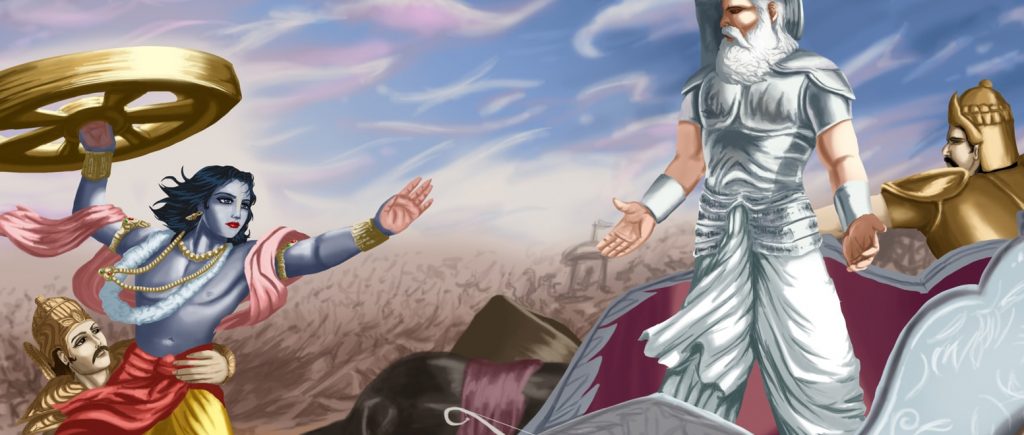
The main elements of a daily devotional practice include:
- Heart-centered prayer
- Kirtan or chanting meditation combined with active visualization
- Aarti-the offering of light – a brief ceremony that reaffirms the spirit of our devotional dedication
Karma Yoga – Dynamic Devotion
For the attainment of divine love, the Vedas state that there is only one rule and one prohibition that apply to bhakti yoga meditation. The rule is: “Always remember Radha Krishna.” The prohibition is, “Never forget Radha Krishna.”
This means that after our sitting meditation, our meditation should continue — while eating, sleeping, walking, working, talking, resting, and so on.
Wherever you are, all the time, whatever you are doing, remember your divine beloved and don’t forget Him! This simultaneous devotion and action is karma yoga. This state of devotional consciousness is cultivated over time with practice.
For example, in the old days street musicians with hand organs kept small monkeys. A monkey by nature is extremely active. How to make a monkey’s nature conform to sitting still, and that, too, in a confined space?

The musician’s technique was to first restrain the monkey with a 100-foot rope. If the monkey tried to go outside of this range, he was stopped. He thought, “Okay, I’ll jump around in a 100-foot area.”
When he was tied with a 50-foot rope he thought, “I went 100 feet yesterday, today I’m restricted to this much.” So he jumped around in a 50-foot area.
When the monkey was finally limited to only 1 foot of rope, he sat quietly, “Why should I drive myself crazy? I’ll just sit here.”
The human mind has this same monkey-like nature. It roams far and wide. Our goal is not to tame it’s active nature, but to train it to roam in a particular area. This is done by gently tying it with the devotional rope of love.
In sitting meditation we cultivate a feeling a devotional relationship with God. In active meditation we can continue this in three ways:
- Embed your intention — Every person has a mission that guides his life’s activities. For example, very few people like to work, but they do it because their mission is to support themselves or their family. While they are at work, although this motive is hidden deep in their mind, it still guides their decisions and actions.Similarly, when we firmly understand the purpose of our life is God-realization, this intention deeply embeds itself in the mind. If cultivated properly, this subconscious devotional intention remains in all our activities, even when we are sleeping.
- Feel divine presence — in sitting meditation we visualize and feel our relationship to God’s personal form. In activity, take hourly breaks for 30 seconds or a minute and with open eyes sense the presence of your worshipped form of God or Radha Krishna. Simply feel you are not alone. Imagine them near or far, sitting, standing or in any position, in any mood of love.
- Share your awareness — After visualizing God’s presence, either feel He is watching you or that you are showing Him what you are doing.
- Avoid wrong association — your associations and environment will affect your feeling of divine connection. Be mindful and avoid those situations that divert your devotional intention.
There is no restriction of time, place and activity for this remembrance. It can be done anywhere, at any time. You do not need to sit in a particular position or have closed eyes. This very simple practice will recall the blissful feelings of your seated meditation and help to stabilize your devotional experience.
Follow us on Facebook
Follow us on Twitter
Latest


Seven Vows and Steps (pheras) of Hindu Wedding explained
Views: 9,199 Indian marriages are well renowned around the world for all the rituals and events forming part of the...


Sari or Saree is symbol of Indian feminism and culture
Views: 7,422 One of the most sensual attires of a woman in India is undoubtedly the sari. It is a...


Atithi Devo Bhava meaning in Hinduism and India
Views: 7,190 Atithi Devo Bhava, an ancient line taken from the Hindu scriptures and was originally coined to depict a visiting person whose...


Sanskrit Is More Than Just A Method To Communicate
Views: 5,390 -By Ojaswita Krishnaa Chaturvedi anskrit is the language of ancient India, the earliest compilation of sound, syllables and...


Significance of Baisakhi / Vaisakhi
Views: 6,613 Baiskhi is also spelled ‘Vaisakhi’, and is a vibrant Festival considered to be an extremely important festival in...


Navaratri: The Nine Divine Nights of Maa Durga!
Views: 7,719 – Shri Gyan Rajhans Navratri or the nine holy days are auspicious days of the lunar calendar according...


History of Vastu Shastra
Views: 10,936 Vastu Shastra (or short just Vastu) is the Indian science of space and architecture and how we may...


Significance of Bilva Leaf – Why is it dear to Lord shiva?
Views: 10,565 – Arun Gopinath Hindus believe that the knowledge of medicinal plants is older than history itself, that it...


Concept of Time and Creation (‘Brahma Srishti’) in Padma Purana
Views: 10,847 Pulastya Maha Muni affirmed to Bhishma that Brahma was Narayana Himself and that in reality he was Eternal....


Karma Yoga – Yog Through Selfless Actions
Views: 9,721 Karma Yoga is Meditation in Action: “Karma” means action and “yoga” means loving unity of our mind with...


Hindu devotee
July 29, 2021 at 4:03 pm
In some of you post I read about there is jo caste system in hindu but here in this post you talk about brahmin is superior there is lower caste in hindu and bla bla bla brahmin doesn’t oppressed others they why all these invasion target only brahmin and killed only brahmin?? others may also refused to convert! If according to your logic only brahmin refused to convert then there should be only brahmin remained in hindu( In some of your post you said there is no caste system which also contradict here) how come there is other varna and ultimately caste remained in hindu??? this completely shows that you only write this post to get some sympathy not more that that! If sudra not even reading the sastras if he only listen to the hindu sastras the hot oil and hot iron is used to damaged his/her ears isn’t this proof of brahmin oppression?? how come only brahmin remain educated and other not?? how come all indian fields like politics bureaucracy captured all by brahmin not by other caste(you said there is not caste in hindu but in reality there is no caste means there is no hindu). I can give you many example….